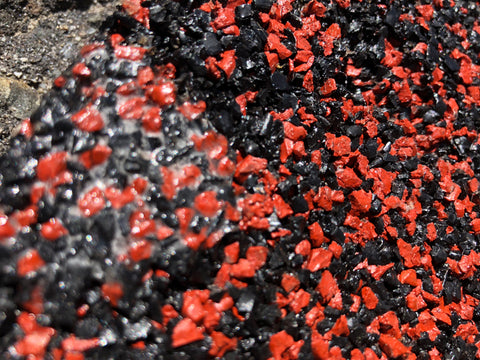No Products in the Cart
Damage to playground rubber flooring doesn't start with a hole. When you see a hole in the playground rubber surface, you are looking at one of the last stages of deterioration. Before we get to that stage let's review what makes your rubber flooring what it is. We are using the colloquial term "rubber flooring" here to refer to all poured in place rubber surfaces. By that we are referring to two layer systems, not bonded rubber which consists typically of one layer of shredded rubber.
Poured in place rubber systems have two layers: A base layer, also known as the impact attenuation layer. This layer is typically made of recycled SBR rubber, or tire buffings, a by product of retreading commercial tires. The base layer varies in thickness based on the fall height of the equipment that it surrounds. This property is called: The critical fall height. For example, if the fall height of the playground equipment is 4 feet, the critical fall height of the base layer must be at least 4 feet for it to comply with ASTM and CPSC codes. Not all base layers are created equal. The installer has a lot of control over how bouncy the base layer is depending on how forceful he or she is with the troweling. In other words, you can have two different readings for a critical fall height from two different spots that utilize the same materials but are installed by two different people.
The wear layer of the poured in system usually has one thickness, typically half inch. Some installers will install the layer thicker in high traffic areas, such as slide exits and under swings. The wear layer's job is to protect the base layer and to give the playground its nice colorful finish. It takes all the abuse from the kids and adults walking on it. The wear layer is make up of EPDM rubber and is troweled differently than the base layer. While the based layer is packed down after it's mixed with the glues, the wear layer is troweled a bit more vigorously and the EPDM granules are "closed" in a sweeping motion. Also because the proportion of binder to rubber is a lot higher in wear layer than base layer, the wear layer is a lot denser and packed closer than the base layer. This gives the rubber the tensile strength that will come in handy in taking all pounding it does throughout its shelf life.

So what causes the holes we talked about in the rubber flooring? Do you remember the binders used to hold the EPDM granules together in the first place? Those binders fall within the family of polyurethane binders. Aliphatic and to larger extent Aromatic binder have one Achilles heal, which is: They are degraded by UV rays. Now imagine a bunch rubber granules held together by glue. That glue slowly disappears with the sun beating down on it and foot traffic dislodging it as the bond becomes weak enough. When more granules dislodge, the wear layer becomes thinner and thinner. That's when you see a sea of loose granules on the perimeter of the playground and on kids' shoes and hands. If the playground surface is not sealed yet, that process will continue into cracks, as the tensile strength of the wear layer weakens. The cracks give the kids a reason to pull as well as becoming a tripping hazard. Before you know it, these cracks become holes as the base layer is exposed.
When the base layer in a poured in place rubber system is exposed,the problem becomes bigger, and the solution more expensive. If it's just a few holes here and there, one needs to patch both base layer and wear layers. If there are holes everywhere, a recap might be in order. That's when an entire wear layer - another half inch - is added to the system. One has to be careful here to patch the base layer with base layer material first before adding the wear layer. The two systems are not interchangeable. If wear layer material is used to patch base layer, the rubberized floor will be harder and fail the HIC test.